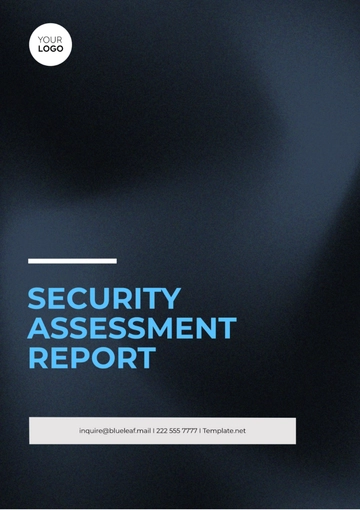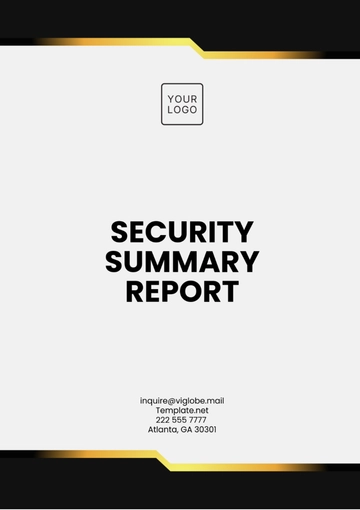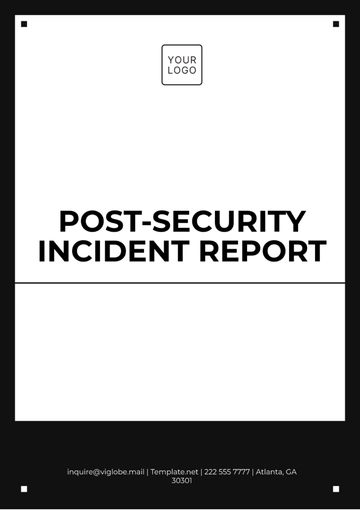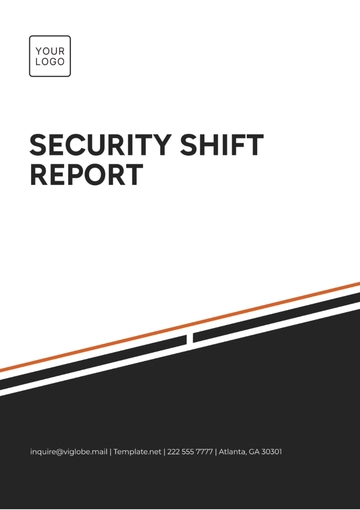Free Loss Prevention Security Report

Prepared by: [Your Name]
I. Introduction
Loss prevention security is a critical component for any business aiming to safeguard its assets. This report provides an in-depth analysis of current loss prevention strategies, identifies existing vulnerabilities, and proposes actionable solutions to enhance security measures.
II. Current Security Strategies
A. Surveillance Systems
Surveillance systems are one of the primary methods used by businesses to deter and detect theft and other unlawful activities. In this section, we examine the various types of surveillance technology employed in loss prevention.
The table below outlines the common types of surveillance systems:
Type of Surveillance | Description |
|---|---|
CCTV Cameras | Closed-circuit television cameras offer real-time monitoring and recording capabilities. |
IP Cameras | Internet Protocol cameras allow for remote access and are integrated with network systems. |
Motion Detectors | Sensors that detect unauthorized movements, triggering alerts or alarms. |
B. Security Personnel
The presence of security personnel is another essential aspect of loss prevention. Personnel are tasked with patrolling premises, responding to incidents, and ensuring compliance with security protocols.
Role in monitoring entry and exit points.
Importance of regular training and updates on security procedures.
Use of technology to aid in patrols and surveillance tasks.
III. Vulnerabilities in Current Systems
A. Technological Challenges
With the advancement of technology, businesses must adapt to new challenges including cybersecurity threats and system malfunctions. This section delves into the technical vulnerabilities present in existing surveillance and detection systems.
Cybersecurity threats affecting IP camera systems.
Potential for equipment failure or obsolescence.
Limitations in current facial recognition software accuracy.
B. Human Factors
Human error or misconduct can significantly impact the effectiveness of loss prevention strategies. Here, we explore the common human-related vulnerabilities:
Ineffective security personnel deployment and management.
Insufficient training leading to protocol non-compliance.
Poor coordination between security teams and other departments.
IV. Recommendations for Improvement
A. Enhancing Technology Use
To address the technological vulnerabilities identified, businesses can adopt several strategies. This section outlines recommended improvements for increasing the effectiveness of technology in loss prevention.
Upgrading to more advanced surveillance systems with AI capabilities.
Implementing robust cybersecurity measures for all digital tools.
Regular maintenance schedules to ensure equipment functionality.
B. Strengthening Human Elements
To mitigate human-related vulnerabilities, organizations need to focus on improving personnel management and training programs. These recommendations provide a framework for strengthening the role of security personnel in loss prevention.
Conducting bi-annual security training for all personnel.
Establishing clear communication channels between security and other departments.
Implementing performance assessments to identify and address gaps in practice.
V. Conclusion
This report has highlighted the importance of a comprehensive loss prevention strategy that incorporates both technological tools and human resources. By addressing current vulnerabilities and implementing recommended improvements, businesses can significantly enhance their security posture, thus safeguarding their assets and minimizing potential losses.
- 100% Customizable, free editor
- Access 1 Million+ Templates, photo’s & graphics
- Download or share as a template
- Click and replace photos, graphics, text, backgrounds
- Resize, crop, AI write & more
- Access advanced editor
Streamline your security reporting with Template.net's Loss Prevention Security Report Template. This fully editable and customizable document is designed to meet all your reporting needs. Enhanced by an AI Editable Tool, it’s easy to personalize and adapt, saving you time while ensuring thorough, professional reports every time. Perfect for businesses focused on efficient security management.
You may also like
- Sales Report
- Daily Report
- Project Report
- Business Report
- Weekly Report
- Incident Report
- Annual Report
- Report Layout
- Report Design
- Progress Report
- Marketing Report
- Company Report
- Monthly Report
- Audit Report
- Status Report
- School Report
- Reports Hr
- Management Report
- Project Status Report
- Handover Report
- Health And Safety Report
- Restaurant Report
- Construction Report
- Research Report
- Evaluation Report
- Investigation Report
- Employee Report
- Advertising Report
- Weekly Status Report
- Project Management Report
- Finance Report
- Service Report
- Technical Report
- Meeting Report
- Quarterly Report
- Inspection Report
- Medical Report
- Test Report
- Summary Report
- Inventory Report
- Valuation Report
- Operations Report
- Payroll Report
- Training Report
- Job Report
- Case Report
- Performance Report
- Board Report
- Internal Audit Report
- Student Report
- Monthly Management Report
- Small Business Report
- Accident Report
- Call Center Report
- Activity Report
- IT and Software Report
- Internship Report
- Visit Report
- Product Report
- Book Report
- Property Report
- Recruitment Report
- University Report
- Event Report
- SEO Report
- Conference Report
- Narrative Report
- Nursing Home Report
- Preschool Report
- Call Report
- Customer Report
- Employee Incident Report
- Accomplishment Report
- Social Media Report
- Work From Home Report
- Security Report
- Damage Report
- Quality Report
- Internal Report
- Nurse Report
- Real Estate Report
- Hotel Report
- Equipment Report
- Credit Report
- Field Report
- Non Profit Report
- Maintenance Report
- News Report
- Survey Report
- Executive Report
- Law Firm Report
- Advertising Agency Report
- Interior Design Report
- Travel Agency Report
- Stock Report
- Salon Report
- Bug Report
- Workplace Report
- Action Report
- Investor Report
- Cleaning Services Report
- Consulting Report
- Freelancer Report
- Site Visit Report
- Trip Report
- Classroom Observation Report
- Vehicle Report
- Final Report
- Software Report





























